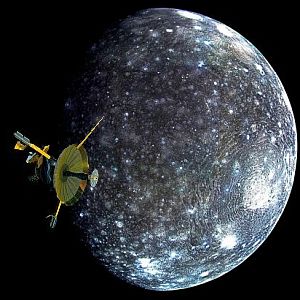
Für eine deutsche Übersetzung dieser Seite einfach die Brandenburger Flagge anklicken
 |
Click the Brandenburg Flag for a German translation Für eine deutsche Übersetzung dieser Seite einfach die Brandenburger Flagge anklicken |


|
|
CallistoA collection of pictures of Jupiter's moon Callisto,
|
|



|
Callisto is the second-largest moon of Jupiter. Of the four
Galilean moons, Callisto is the furthest out. Callisto's surface is completely covered with impact craters, featuring multi-ring structures, variously shaped craters, and chains of craters, ridges and deposits. It is the oldest and most heavily cratered surface of any body in the Solar System. It's remote orbit just outside Jupiter's main radiation belt makes it the ideal candidate for a human base, which according to NASA cold be possible in the 2040s.
The picture to the left was taken by the Galileo space probe in May 2001. |

|
Callisto was discovered on January 10, 1610 by Galileo Galilei. The Galilean moons were the first
discoveries of moons in the solar system other than Earth's moon. They also were the first objects discovered using a telescope. For the next 350 years, due to the limited resolution of telescopes, Callisto and the other Galilean moons remained nothing more than light spec in a telescope. The Pioneer probes, that delivered the first images of Io and Europa did not take any pictures of Callisto that were better than pictures obtained by terrestrial telescopes. The first closeup pictures of Callisto were taken by the Voyager spacecraft. The picture to the right is a mosaic of three pictures taken by Voyager 1 on March 5, 1979 from a distance of 1,200,500 km (746,000 miles). Voyager 1 got some impressive closeups during its flyby. |
  Mosaic of the first pictures taken by Voyager 1 Source: NASA / Planetary Society |

  Callisto from a distance of 350,000 km Source: NASA |
  Valhalla Crater Source: NASA / Wikipedia |

|
NASA's Galileo probe entered Jupiter's orbit on December 8, 1995 and remained in orbit
until September 21, 2003. In November 1997, the probe started its Galileo Europa mission. Following eight consecutive Europa flybys through February 1999, the probe performed four close flybys of Callisto, closing in up to 1,057 km (656 miles). |

  Artist's concept of Galileo passing Callisto Source: Wikimedia & incado.com |
  Callisto from 687,000 km November 5, 1997 Source: NASA / Planetary Society |
  Callisto from 744,000 km May 26, 2001 Source: NASA / Planetary Society |


  Crater Tindr October 7, 1999 Source: NASA / JPL |
  Landslide deposits within two large impact craters September 16, 1997 Source: NASA / JPL |
  Heavily cratered surface October 13, 1998 Source: NASA / JPL |

|
Among the most impressive features on Callisto are catenae, crater chains formed by the
impact of a body that was broken up by the tidal forces of the planet into a string of smaller objects. The first time, such an impact was observed was the breakup of comet Shoemaker–Levy 9 and its subsequent impact on Jupiter in May 1994. The picture up left show a Hubble Image of the broken up comet. There are eight confirmed primary catenae on Callisto, evidence of Jupiter's gravity and its strong tidal forces. |
  Gipul Catena Source: NASA / Calvin J. Hamilton |
  Gomul Catena Source: NASA / Wikipedia |




|
The Planetary Society and the
JPL Photo Journal host large collections of images taken
by Galileo. Aside from the Pioneer and Voyager probes and the two satellites Galileo and Juno, the only spacecraft that came somewhat close to Callisto was Cassini, which passed Jupiter on December 30, 2000 in a gravity assist maneuver. Three days after the closest approach to Jupiter, on January 2, 2001, Cassini took a picture of Jupiter and Callisto. New Horizons passed Jupiter on February 28, 2007 in a gravity assist maneuver and took a very faint picture of a crescent of Callisto. |
 Source: Source:NASA APOD |


|
Part of the Galileo Europa mission were a number of close flybys of Ganymede, not only the largest of the Galilean moons but the largest moon of any planet in our Solar System. |

|


|
|
Click here to return to Jupiter's moon Europa | Click here to move on to Jupiter's moon Ganymede |
|

|
Back to Solar System Page |
Back to Space Page |
Back to English Main Page |
 Back to Start Page |